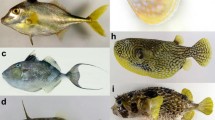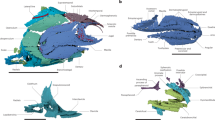Synopsis
A total of 121 actinistian species belonging to 47 genera and 17 undetermined actinistians is reported from the literature. There are 69 valid species with fair assessment of their phylogenetic position; 21 valid species with poor assessment of their phylogenetic position; 31 actinistian incertae sedis; and 18 taxa that had been identified incorrectly as actinistians or are nomen nuda. The fossil record of the actinistians covers a history of approximately 380 million years. The greatest diversity occurred during the Scythian (Early Triassic).
Similar content being viewed by others
References cited
See ‘References cited’ in Forey & Cloutier (1991) for all taxonomic references.
Cloutier, R. 1991. Patterns, trends, and rates of evolution within the Actinistia. Env. Biol. Fish. 32: 23–58. (this volume)
Dagnelie, P. 1977. Théorie et méthodes statistiques. Applications agronomiques. Vol. 1, 2nd ed. Presses Agronomiques de Gembloux, Gembloux. 378 pp.
Denison, R.H. 1978. Placodermi. pp. 1–62. In: H.-P. Schultze (ed.) Handbook of Paleoichthyology, Vol. 2., Gustav. Fischer Verlag, Stuttgart.
Forey, P.L. 1991. Latimeria chalumnae and its pedigree. Env. Biol. Fish. 32: 75–97. (this volume)
Forey, P.L. & R. Cloutier. 1991. Literature relating to fossil coelacanths. Env. Biol. Fish. 32: 391–401. (this volume)
Holmes, A. 1959. A revised geological time scale. Trans. Edinburgh Geol. Soc. 17: 183–216.
Lenoble, J. & Y. Le Grand. 1954. Le tapis de l'oeil du coelacanthe (Latimeria anjouanae [Smith]). Bull. Mus. Hist. nat., Paris 26: 460–463.
Palmer, A.R. 1983. The decade of North American geology. 1983. Geologic time scale. Geology 11: 503–504.
Raup, D.M., S.J. Gould, T.J.M. Schoff & D.S. Simberloff. 1973. Stochastic models of phylogeny and the evolution of diversity. J. Geol. 81: 525–542.
Ride, W.D.L., C.W. Sabrosky, G. Bernardi & R.V. Melville(ed.). 1985. International Code of Zoological Nomenclature. XX General Assembly of the International Union of Biological Sciences. International Trust for Zoological Nomenclature. H. Charlesworth & Co. Ltd., Huddersfield. 338 pp.
Schaeffer, B. & M. Mangus. 1976. An early Triassic fish assemblage from British Columbia. Bull. Amer. Mus. Nat. Hist. 156: 517–563.
Smith, A.B. & C. Patterson. 1988. The influence of taxonomic method on the perception of patterns of evolution. Evol. Biol. 23: 127–216.
Thomson, K.S. 1977. The pattern of diversification among fishes. pp. 377–404. In: A. Hallam (ed.) Patterns of Evolution, as Illustrated by the Fossil Record, Development in Palaeontology and Stratigraphy, Vol. 5, Elsevier, Amsterdam.
Vorobyeva, E.I. & D.V. Obruchev. 1967. Subclass Sarcopterygii. pp. 420–509. In: Y.A. Orlov (ed.) Fundamentals of Paleontology, Vol. XI Agnatha, Pisces, Israel Program for Scientific Translations, Jerusalem. (Russian original 1964).
Author information
Authors and Affiliations
Rights and permissions
About this article
Cite this article
Cloutier, R., Forey, P.L. Diversity of extinct and living actinistian fishes (Sarcopterygii). Environ Biol Fish 32, 59–74 (1991). https://doi.org/10.1007/BF00007445
Received:
Accepted:
Issue Date:
DOI: https://doi.org/10.1007/BF00007445




